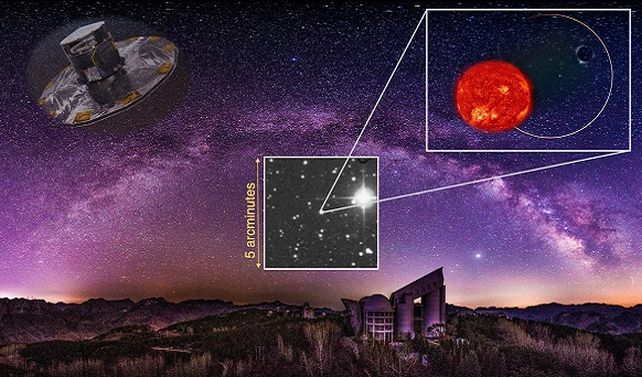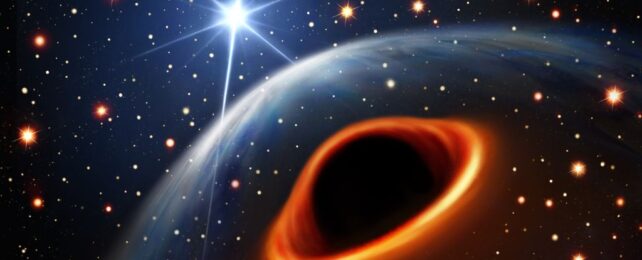A star wiggling oddly around in space may be the signpost to one of the most sought-after objects in the galaxy.
Some 5,825 light-years from Earth, a red giant star has been spotted moving as though in a slow orbital dance with a binary companion. The problem? There's absolutely no light coming from the place where the binary companion should be.
It gets more interesting. Based on the behavior of the red giant, astronomers led by Song Wang of the Chinese Academy of Sciences have determined that the mass of the invisible object is just 3.6 times the mass of the Sun. There's only one thing it could be: a black hole, one with a petite size that's smack bang in the middle of a mysterious void in the data known as the lower mass gap.
Named G3425, it might have a lot to teach us about tiny black holes according to an analysis.
"The rare discovery of G3425 provides evidence for the existence of mass-gap black holes in non-interacting binaries, which is hard to detect through X-ray emission," the researchers write in their paper.
"More notably, the formation of its surprisingly wide circular orbit challenges current binary evolution and supernova explosion theories."
Black holes are on a continuum of ultradense objects that form from the remnant cores of dead stars after they run out of fuel and collapse under gravity. White dwarfs form from stars up to about eight times the mass of the Sun, and have an upper mass limit of about 1.4 times the Sun's mass.
Heavier objects become even more dense; those are neutron stars, up to around 2.3 solar masses (although there can be a bit of overlap between the mass ranges).
Above 2.3 solar masses, according to our best models, a neutron star can no longer withstand the inward pressure of gravity. It should collapse completely, forming a black hole.
This is where the mass gap comes in. We have detected extremely few black hole candidates below five solar masses. Either we're really bad at finding them, or something is preventing them from forming.
Being really bad at finding them isn't entirely outside the realm of possibility, actually. Unless they're actively growing – a process that generates X-radiation from the material swirling around the black hole under extreme gravitational influences – black holes are very hard to spot. They can have an effect on things around them, but the smaller the black hole, the less pronounced this effect.
The European Space Agency's Gaia mission, however, is giving us an excellent tool to find the invisible. The long-term mission is mapping the Milky Way in three dimensions, including the stars' motions and velocities. This means when we find a star that seems to be in a dance with nothing, we can now take a closer look to see what might – or might not – be there.

This is what led Wang's team to G3425. They used spectroscopy from the Chinese Academy of Science's Large Aperture Multi-Object Spectroscopic Telescope to look for changes in the light of a star as it moves about the binary's mutual center of gravity, and they used Gaia data to look for the motions of stars in space.
The red giant star in G3425 has an estimated mass of about 2.7 Suns. And its motion suggests that it's on a relatively wide orbit, taking around 880 days to move around a mutual center of gravity with an object calculated at around 3.6 times the mass of the Sun.
That orbit, according to the team's modeling, is pretty circular. Other stellar-mass black holes in binary systems tend to have elliptical orbits. A circular orbit means that the binary has been stable and undisturbed for a long time; it's not really consistent with our understanding of black hole binaries, since the supernova that produces the black hole can create quite a big disturbance, kicking the black hole itself either off-kilter or clean across space at high speeds.
G3425 raises some questions. But it may contain some answers, too. The best way to get those answers will be to find more low-mass black holes sprinkled across the galaxy, and use statistical data to figure out the different ways black holes can form, based on what we find.
"Future spectroscopic and astrometric observations," the researchers write, "may help to unveil a low-mass black-hole binary population with a variety of parameters and provide profound insights into the formation and evolution of binary systems."
The research has been published in Nature.
